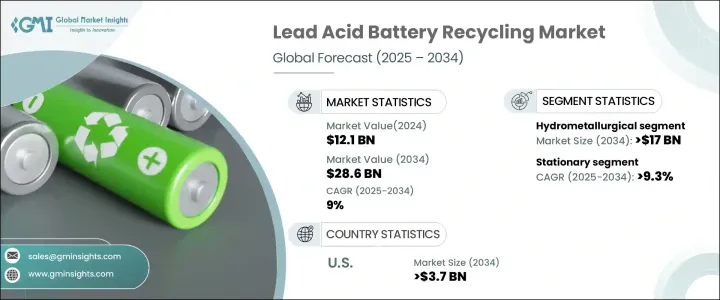 |
市場調查報告書
商品編碼
1684672
鉛酸電池回收市場機會、成長動力、產業趨勢分析與預測 2025 - 2034Lead Acid Battery Recycling Market Opportunity, Growth Drivers, Industry Trend Analysis, and Forecast 2025 - 2034 |
||||||
全球鉛酸電池回收市場價值 121 億美元,2024 年預計將大幅成長,預計 2025 年至 2034 年的複合年成長率為 9%。回收過程通常包括拆卸電池組件、提取鉛及其化合物、中和硫酸以及重新利用塑膠外殼以備將來使用。隨著各行各業都優先考慮永續性,有效的回收解決方案的重要性不斷受到關注,使得這個市場成為全球環境策略的重要組成部分。

人們越來越意識到不當電池處理帶來的環境風險,這是市場擴張的主要動力。如果不加以負責任地管理,鉛和硫酸會嚴重污染土壤和水,造成長期的生態和健康危害。回收可以減輕這些危險,並最大限度地減少對新的鉛開採的需求,鉛開採是一項以能源密集和環境破壞性而聞名的活動。透過重新使用鉛和塑膠等有價值的材料,回收過程進一步符合全球永續發展目標。隨著政府監管的不斷加強以及消費者對綠色實踐的倡導,全球範圍內鉛酸電池回收的採用正在加速。
| 市場範圍 | |
|---|---|
| 起始年份 | 2024 |
| 預測年份 | 2025-2034 |
| 起始值 | 121億美元 |
| 預測值 | 286億美元 |
| 複合年成長率 | 9% |
濕式冶金製程正在成為業界變革的一大因素,預計到 2034 年將創造 170 億美元的產值。其更高的材料產量,加上能源效率和成本效益,正在推動其在回收設施中的廣泛應用。隨著行業傾向於永續和高產量的回收方法,濕式冶金製程預計將在未來幾年佔據主導地位。
隨著對可靠能源儲存解決方案的需求不斷成長,到 2034 年,回收鉛酸電池的固定應用將以 9.3% 的強勁複合年成長率成長。這些電池對於備用電源系統和再生能源應用(包括太陽能和風能儲存)至關重要。先進回收技術的開發確保了延長電池壽命和提高成本效率,從而促進了其在固定應用中的採用。隨著電池回收領域的不斷創新,製造商正在將更多的回收材料融入他們的產品中,進一步支持產業成長。
在美國,鉛酸電池回收市場預計到 2034 年將創造 37 億美元。住宅、商業和工業領域對能源儲存解決方案的需求不斷成長,特別是對備用電源和再生能源整合的需求,正在推動市場擴張。這些趨勢凸顯了電池回收產業對永續性和高效資源利用的日益重視。
目錄
第 1 章:方法論與範圍
- 市場定義
- 基礎估算與計算
- 預測計算
- 初步研究與驗證
- 主要來源
- 資料探勘來源
- 市場定義
第 2 章:執行摘要
第 3 章:產業洞察
- 產業生態系統
- 監管格局
- 產業衝擊力
- 成長動力
- 產業陷阱與挑戰
- 成長潛力分析
- 波特的分析
- PESTEL 分析
第4章:競爭格局
- 介紹
- 戰略儀表板
- 創新與技術格局
第 5 章:市場規模及預測:依製程分類,2021 年至 2034 年
- 主要趨勢
- 火法冶金
- 濕式冶金
- 物理/機械
第 6 章:市場規模與預測:按應用,2021 – 2034 年
- 主要趨勢
- 星光
- 固定式
- 其他
第 7 章:市場規模及預測:按地區,2021 – 2034 年
- 主要趨勢
- 北美洲
- 美國
- 加拿大
- 歐洲
- 英國
- 西班牙
- 德國
- 法國
- 亞太地區
- 中國
- 韓國
- 日本
- 印度
- 世界其他地區
第8章:公司簡介
- Amara Raja
- Aqua Metals
- Cirba Solutions
- East Penn Manufacturing Company
- EnerSys
- Exide
- Glencore
- GME Recycling
- Gravita India
- Umicore
- Yuasa Battery
The Global Lead Acid Battery Recycling Market, valued at USD 12.1 billion in 2024, is poised for significant growth, with projections indicating a 9% CAGR from 2025 to 2034. This dynamic market centers on the collection and processing of used lead acid batteries (ULABs) to recover essential materials, including lead, sulfuric acid, and plastic. The recycling process typically involves dismantling battery components, extracting lead and its compounds, neutralizing sulfuric acid, and repurposing plastic casings for future use. As industries prioritize sustainability, the importance of effective recycling solutions continues to gain traction, making this market a critical component of global environmental strategies.

The rising awareness of the environmental risks associated with improper battery disposal is a major driver of market expansion. Lead and sulfuric acid, if not managed responsibly, can severely contaminate soil and water, posing long-term ecological and health hazards. Recycling mitigates these dangers and minimizes the need for new lead mining, an activity known for its energy-intensive and environmentally damaging nature. By reusing valuable materials, such as lead and plastic, the recycling process further aligns with global sustainability goals. With increasing government regulations and consumer advocacy for greener practices, the adoption of lead acid battery recycling is accelerating worldwide.
| Market Scope | |
|---|---|
| Start Year | 2024 |
| Forecast Year | 2025-2034 |
| Start Value | $12.1 Billion |
| Forecast Value | $28.6 Billion |
| CAGR | 9% |
The hydrometallurgical process is emerging as a game-changer in the industry, projected to generate USD 17 billion by 2034. Offering notable environmental and economic advantages, this method ensures efficient recovery of lead and other valuable metals like cobalt and nickel. Its higher material yield, combined with energy efficiency and cost-effectiveness, is driving widespread adoption among recycling facilities. As the industry leans towards sustainable and high-yield recycling methods, hydrometallurgical processes are expected to dominate in the coming years.
Stationary applications of recycled lead acid batteries are set to grow at a robust CAGR of 9.3% through 2034, driven by increasing demand for reliable energy storage solutions. These batteries are critical for backup power systems and renewable energy applications, including solar and wind energy storage. The development of advanced recycling technologies, ensuring extended battery lifecycles and cost-efficient processes, is bolstering their adoption in stationary applications. As innovations in battery recycling continue, manufacturers are integrating more recycled materials into their products, further supporting industry growth.
In the United States, the lead acid battery recycling market is projected to generate USD 3.7 billion by 2034. This growth is underpinned by stringent environmental regulations mandating responsible battery disposal and recycling. The rising demand for energy storage solutions across residential, commercial, and industrial sectors, particularly for backup power and renewable energy integration, is fueling market expansion. These trends highlight the growing emphasis on sustainability and efficient resource utilization in the battery recycling sector.
Table of Contents
Chapter 1 Methodology & Scope
- 1.1 Market definitions
- 1.2 Base estimates & calculations
- 1.3 Forecast calculation
- 1.4 Primary research & validation
- 1.4.1 Primary sources
- 1.4.2 Data mining sources
- 1.5 Market definitions
Chapter 2 Executive Summary
- 2.1 Industry synopsis, 2021 – 2034
Chapter 3 Industry Insights
- 3.1 Industry ecosystem
- 3.2 Regulatory landscape
- 3.3 Industry impact forces
- 3.3.1 Growth drivers
- 3.3.2 Industry pitfalls & challenges
- 3.4 Growth potential analysis
- 3.5 Porter's analysis
- 3.5.1 Bargaining power of suppliers
- 3.5.2 Bargaining power of buyers
- 3.5.3 Threat of new entrants
- 3.5.4 Threat of substitutes
- 3.6 PESTEL analysis
Chapter 4 Competitive landscape, 2024
- 4.1 Introduction
- 4.2 Strategic dashboard
- 4.3 Innovation & technology landscape
Chapter 5 Market Size and Forecast, By Process, 2021 – 2034 (USD Billion)
- 5.1 Key trends
- 5.2 Pyrometallurgical
- 5.3 Hydrometallurgical
- 5.4 Physical/Mechanical
Chapter 6 Market Size and Forecast, By Application, 2021 – 2034 (USD Billion)
- 6.1 Key trends
- 6.2 SLI
- 6.3 Stationary
- 6.4 Others
Chapter 7 Market Size and Forecast, By Region, 2021 – 2034 (USD Billion)
- 7.1 Key trends
- 7.2 North America
- 7.2.1 U.S.
- 7.2.2 Canada
- 7.3 Europe
- 7.3.1 UK
- 7.3.2 Spain
- 7.3.3 Germany
- 7.3.4 France
- 7.4 Asia Pacific
- 7.4.1 China
- 7.4.2 South Korea
- 7.4.3 Japan
- 7.4.4 India
- 7.5 Rest of World
Chapter 8 Company Profiles
- 8.1 Amara Raja
- 8.2 Aqua Metals
- 8.3 Cirba Solutions
- 8.4 East Penn Manufacturing Company
- 8.5 EnerSys
- 8.6 Exide
- 8.7 Glencore
- 8.8 GME Recycling
- 8.9 Gravita India
- 8.10 Umicore
- 8.11 Yuasa Battery













